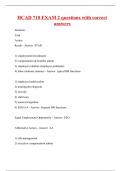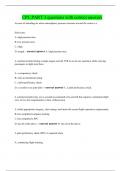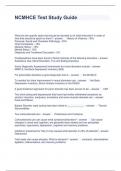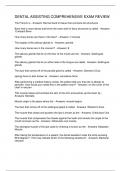ECO3020F
Week 1
Revision:
• Pareto criteria= No one must be made worse off to make anyone better off.
• Pareto comparisons= an outcome is Pareto superior to another if it allows at least
one person to be better off without anyone else being worse off.
• Outcomes can be (pareto) ranked
• Pareto efficient= no other feasible outcome is Pareto superior to it.
• Outcomes cannot be (pareto) ranked.
• Cannot pick a winner, only avoid losers.
Pareto comparison & efficiency:
• Pareto criteria= no one must be made worse-off to make anyone better-off.
• Pareto superior= allows at least one of those involved to be better off without
anyone being worse off.
• A Pareto-superior outcome is also called a Pareto improvement over the outcome it
was compared to.
• Pareto efficient= if no other feasible outcome is Pareto superior to it.
• If we can rank 2 outcomes such that one is Pareto superior to the other, then we say
that these two outcomes can be Pareto compared.
They are relative. Must be compared to something. Superior or an improvement from
something
Pareto criterion: strength & weakness
• Pareto efficiency cannot pick a winner- only helps us avoid losers.
• Which efficient outcome is “good” and which is “bad”?
• Too strong? May result in status quo bias (unwillingness to change current
policies/institutions)
• Too weak? Efficient but may not be desirable for society.
• Be mindful of the fact that efficiency and equity are two different goals.
Utility maximisation:
• Marginal rate of transformation (MRT)
𝑑𝑦
• 𝑴𝑹𝑻(𝑥, 𝑦) = − 𝑑𝑥
• As move along feasible frontier MRT increasing (due to increasing opportunity costs)
• IC = combo of bundles of goods that give consumer same utility
• tells us about tradeoffs
1
, • (Negative) of slope of IC represents the MRS (how much y are you willing to
give up to get one more unit of x).
Completeness: (x,y) > (x’,y’) OR (x’, y’) > (x,y) OR (x’,y’)=(x,y)
• Then, u(x,y) > u(x’,y’) OR u(x’, y’)> u(x,y) OR u(x’,y’)=u(x,y)
Consistency/Transitivity: (x,y)> (x’,y’) and (x’, y’)> (x”,y”), then (x,y)>(x”,y”)
• Then, u(x,y)> u(x’,y’) and u(x’, y’)> u(x”,y”), then u(x,y)>u(x”,y”)
Interdependencies= my response conditional on the other players response – are the core
of social dilemma.
Deriving MRS mathematically:
• Suppose we have: 𝑦 = 3𝑥 2 +4𝑧 2
• If x and z are independent of each other, we can use PARTIAL differentiation to
assess how y changes when x changes
𝝏𝒚
• = 𝟔𝒙
𝝏𝒙
• If x and z are interdependent of each other, we can use TOTAL differentiation to
assess how y changes when x changes
𝑑𝑦 = (6𝑥) 𝑑𝑥 + (8𝑧) 𝑑𝑧
Examples:
𝐹𝑖𝑛𝑑 𝑑𝑧:
𝒛 = 𝟑𝒙𝟐 + 𝒙𝒚 − 𝟐𝒚𝟑
Answer:
𝑑𝑧 = (6𝑥 + 𝑦)𝑑𝑥 + (𝑥 − 6𝑦 2 )𝑑𝑦
Find dy:
𝒚 = 𝟒𝒙 − 𝟐𝒙𝒛𝟐
Answer:
𝑑𝑦 = (4 − 2𝑧 2 )𝑑𝑥 − 4𝑥𝑧 𝑑𝑧
2
,Deriving MRS mathematically:
• 𝑢(𝑥, 𝑦) = 𝒖
𝜕𝑢 𝜕𝑢
• 𝑑𝑢 = 𝜕𝑥 𝑑𝑥 + 𝜕𝑦 𝑑𝑦 = 𝑢𝑥 𝑑𝑥 + 𝑢𝑦 𝑑𝑦 = 0
• 𝑢𝑥 𝑑𝑥 = −𝑢𝑦 𝑑𝑦
𝒅𝒚 𝒖
𝐌𝐑𝐒 = − 𝒅𝒙 = 𝒖𝒙
𝒚
Marginal utility & MRS relationship:
• Marginal utility= how much does total utility change as consumption of x by 1 unit
holding y constant (and vice versa).
• Law of diminishing marginal utility= as consume more, each additional unit adds less
and less to utility.
• Slope of IC is just ratios of marginal utilities
𝒖𝒙
• 𝑴𝑹𝑺(𝒙, 𝒚) =
𝒖𝒚
Example:
1 2
• 𝑢(𝑥, 𝑦) = 𝑥 3 𝑦 3
1 2 2 2
1 1
• Find 𝑢𝑥 = 𝑥 3−1 𝑦 3 = 3 𝑥 −3 𝑦 3
3
1 2 1 1
2 2
• Similarly, 𝑢𝑦 = 3 𝑥 3 𝑦 3−1 = 3 𝑥 3 𝑦 −3
𝟐 𝟐
𝟏 −
𝒖𝒙 𝒙 𝟑 𝒚𝟑 𝟏 𝒚
• 𝑴𝑹𝑺(𝒙, 𝒚) = = 𝟑
𝟏 𝟏 = 𝒙−𝟏 𝒚 =
𝒖𝒚 𝟐 − 𝟐 𝟐𝒙
𝒙𝟑 𝒚 𝟑
𝟑
• Willing to give up 1 unit of y to get 2 units of x (provided you have the same amount
of x and y to begin with).
Cobb Douglas utility function:
For individual A: 𝒖(𝒙, 𝒚) = 𝜿𝒙𝜶 𝒚𝜷
• 𝑢𝑥 > 0, 𝑢𝑦 > 0 positive MU
• 𝑢𝑥𝑥 < 0, 𝑢𝑦𝑦 < 0 Diminishing MU
• 𝜅 > 0, 𝛼, 𝛽 > 0 𝑎𝑛𝑑 𝛼 + 𝛽 = 1 (constant returns to scale)
• 𝛼 𝑎𝑛𝑑 𝛽 > 0 Intensity of preference for x relative to y
𝛼 > 𝛽 − 𝑝𝑟𝑒𝑓𝑒𝑟 𝑔𝑜𝑜𝑑 𝑥 𝑡𝑜 𝑔𝑜𝑜𝑑 𝑦
𝛼 < 𝛽 − 𝑝𝑟𝑒𝑓𝑒𝑟 𝑔𝑜𝑜𝑑 𝑦 𝑡𝑜 𝑔𝑜𝑜𝑑 𝑥
𝛼 = 𝛽 − 𝑙𝑖𝑘𝑒 𝑡ℎ𝑒𝑚 𝑒𝑞𝑢𝑎𝑙𝑙𝑦 (𝑐𝑎𝑛 𝑜𝑛𝑙𝑦 𝑜𝑐𝑐𝑢𝑟 𝑖𝑓 𝑡ℎ𝑒𝑦 𝑎𝑟𝑒 𝑏𝑜𝑡ℎ 0.5)
Ultimately, individual just trying to maximise their utility (MRS), given what is feasible
(MRT).
3
, Will occur where:
𝑀𝑅𝑆(𝑥, 𝑦) = 𝑀𝑅𝑇(𝑥, 𝑦)
𝑢𝑥 𝑑𝑦
= - 𝑑𝑥
𝑢𝑦
Microeconomics:
Property and Exchange: Mutual Gains and Conflict
Classical constitutional conundrum= “The problem of finding a set of laws, policies and
social norms (“rules of the game”) so that people are free to choose their actions, whilst
avoiding outcomes that none of them would have chosen had they been able to co-
ordinate (includes mutual gains & conflict).”
formal institutions= law & policies
informal institutions= social norms
Setting the scene:
• We are going to focus on a society with data and coffee, and citizens Ayanda and
Biko.
• The total number of each good in the society is fixed/limited and does not change.
• Combos of goods are called endowments.
• Initial endowments (initial endowment)= goods each person has before any
exchanges (we are going to assume they were randomly allocated those goods).
• Final endowments(post-exchange endowment)= are the goods each person has
after all exchanges.
Indifference curve= all combos of goods which give the same utility (combos for which the
person is indifferent).
Marginal rate of substitution= willingness to pay for a small (marginal) increase in the
amount of good x expressed as how much of good y the person would be willing to give up
for this. The negative of the slope of the indifference curve.
• We will treat MRS as an absolute value (a positive number) even though it is
technically the negative slope.
Feasible frontier= border of the feasible set, showing for any value of good x the max value
of good y that is feasible- the decision-maker can obtain.
Marginal rate of transformation= negative of the slope of the feasible frontier. It measures
the sacrifice of the good y necessary in order to get more of the good x. The opportunity
cost of the x good in terms of the y good.
4
Week 1
Revision:
• Pareto criteria= No one must be made worse off to make anyone better off.
• Pareto comparisons= an outcome is Pareto superior to another if it allows at least
one person to be better off without anyone else being worse off.
• Outcomes can be (pareto) ranked
• Pareto efficient= no other feasible outcome is Pareto superior to it.
• Outcomes cannot be (pareto) ranked.
• Cannot pick a winner, only avoid losers.
Pareto comparison & efficiency:
• Pareto criteria= no one must be made worse-off to make anyone better-off.
• Pareto superior= allows at least one of those involved to be better off without
anyone being worse off.
• A Pareto-superior outcome is also called a Pareto improvement over the outcome it
was compared to.
• Pareto efficient= if no other feasible outcome is Pareto superior to it.
• If we can rank 2 outcomes such that one is Pareto superior to the other, then we say
that these two outcomes can be Pareto compared.
They are relative. Must be compared to something. Superior or an improvement from
something
Pareto criterion: strength & weakness
• Pareto efficiency cannot pick a winner- only helps us avoid losers.
• Which efficient outcome is “good” and which is “bad”?
• Too strong? May result in status quo bias (unwillingness to change current
policies/institutions)
• Too weak? Efficient but may not be desirable for society.
• Be mindful of the fact that efficiency and equity are two different goals.
Utility maximisation:
• Marginal rate of transformation (MRT)
𝑑𝑦
• 𝑴𝑹𝑻(𝑥, 𝑦) = − 𝑑𝑥
• As move along feasible frontier MRT increasing (due to increasing opportunity costs)
• IC = combo of bundles of goods that give consumer same utility
• tells us about tradeoffs
1
, • (Negative) of slope of IC represents the MRS (how much y are you willing to
give up to get one more unit of x).
Completeness: (x,y) > (x’,y’) OR (x’, y’) > (x,y) OR (x’,y’)=(x,y)
• Then, u(x,y) > u(x’,y’) OR u(x’, y’)> u(x,y) OR u(x’,y’)=u(x,y)
Consistency/Transitivity: (x,y)> (x’,y’) and (x’, y’)> (x”,y”), then (x,y)>(x”,y”)
• Then, u(x,y)> u(x’,y’) and u(x’, y’)> u(x”,y”), then u(x,y)>u(x”,y”)
Interdependencies= my response conditional on the other players response – are the core
of social dilemma.
Deriving MRS mathematically:
• Suppose we have: 𝑦 = 3𝑥 2 +4𝑧 2
• If x and z are independent of each other, we can use PARTIAL differentiation to
assess how y changes when x changes
𝝏𝒚
• = 𝟔𝒙
𝝏𝒙
• If x and z are interdependent of each other, we can use TOTAL differentiation to
assess how y changes when x changes
𝑑𝑦 = (6𝑥) 𝑑𝑥 + (8𝑧) 𝑑𝑧
Examples:
𝐹𝑖𝑛𝑑 𝑑𝑧:
𝒛 = 𝟑𝒙𝟐 + 𝒙𝒚 − 𝟐𝒚𝟑
Answer:
𝑑𝑧 = (6𝑥 + 𝑦)𝑑𝑥 + (𝑥 − 6𝑦 2 )𝑑𝑦
Find dy:
𝒚 = 𝟒𝒙 − 𝟐𝒙𝒛𝟐
Answer:
𝑑𝑦 = (4 − 2𝑧 2 )𝑑𝑥 − 4𝑥𝑧 𝑑𝑧
2
,Deriving MRS mathematically:
• 𝑢(𝑥, 𝑦) = 𝒖
𝜕𝑢 𝜕𝑢
• 𝑑𝑢 = 𝜕𝑥 𝑑𝑥 + 𝜕𝑦 𝑑𝑦 = 𝑢𝑥 𝑑𝑥 + 𝑢𝑦 𝑑𝑦 = 0
• 𝑢𝑥 𝑑𝑥 = −𝑢𝑦 𝑑𝑦
𝒅𝒚 𝒖
𝐌𝐑𝐒 = − 𝒅𝒙 = 𝒖𝒙
𝒚
Marginal utility & MRS relationship:
• Marginal utility= how much does total utility change as consumption of x by 1 unit
holding y constant (and vice versa).
• Law of diminishing marginal utility= as consume more, each additional unit adds less
and less to utility.
• Slope of IC is just ratios of marginal utilities
𝒖𝒙
• 𝑴𝑹𝑺(𝒙, 𝒚) =
𝒖𝒚
Example:
1 2
• 𝑢(𝑥, 𝑦) = 𝑥 3 𝑦 3
1 2 2 2
1 1
• Find 𝑢𝑥 = 𝑥 3−1 𝑦 3 = 3 𝑥 −3 𝑦 3
3
1 2 1 1
2 2
• Similarly, 𝑢𝑦 = 3 𝑥 3 𝑦 3−1 = 3 𝑥 3 𝑦 −3
𝟐 𝟐
𝟏 −
𝒖𝒙 𝒙 𝟑 𝒚𝟑 𝟏 𝒚
• 𝑴𝑹𝑺(𝒙, 𝒚) = = 𝟑
𝟏 𝟏 = 𝒙−𝟏 𝒚 =
𝒖𝒚 𝟐 − 𝟐 𝟐𝒙
𝒙𝟑 𝒚 𝟑
𝟑
• Willing to give up 1 unit of y to get 2 units of x (provided you have the same amount
of x and y to begin with).
Cobb Douglas utility function:
For individual A: 𝒖(𝒙, 𝒚) = 𝜿𝒙𝜶 𝒚𝜷
• 𝑢𝑥 > 0, 𝑢𝑦 > 0 positive MU
• 𝑢𝑥𝑥 < 0, 𝑢𝑦𝑦 < 0 Diminishing MU
• 𝜅 > 0, 𝛼, 𝛽 > 0 𝑎𝑛𝑑 𝛼 + 𝛽 = 1 (constant returns to scale)
• 𝛼 𝑎𝑛𝑑 𝛽 > 0 Intensity of preference for x relative to y
𝛼 > 𝛽 − 𝑝𝑟𝑒𝑓𝑒𝑟 𝑔𝑜𝑜𝑑 𝑥 𝑡𝑜 𝑔𝑜𝑜𝑑 𝑦
𝛼 < 𝛽 − 𝑝𝑟𝑒𝑓𝑒𝑟 𝑔𝑜𝑜𝑑 𝑦 𝑡𝑜 𝑔𝑜𝑜𝑑 𝑥
𝛼 = 𝛽 − 𝑙𝑖𝑘𝑒 𝑡ℎ𝑒𝑚 𝑒𝑞𝑢𝑎𝑙𝑙𝑦 (𝑐𝑎𝑛 𝑜𝑛𝑙𝑦 𝑜𝑐𝑐𝑢𝑟 𝑖𝑓 𝑡ℎ𝑒𝑦 𝑎𝑟𝑒 𝑏𝑜𝑡ℎ 0.5)
Ultimately, individual just trying to maximise their utility (MRS), given what is feasible
(MRT).
3
, Will occur where:
𝑀𝑅𝑆(𝑥, 𝑦) = 𝑀𝑅𝑇(𝑥, 𝑦)
𝑢𝑥 𝑑𝑦
= - 𝑑𝑥
𝑢𝑦
Microeconomics:
Property and Exchange: Mutual Gains and Conflict
Classical constitutional conundrum= “The problem of finding a set of laws, policies and
social norms (“rules of the game”) so that people are free to choose their actions, whilst
avoiding outcomes that none of them would have chosen had they been able to co-
ordinate (includes mutual gains & conflict).”
formal institutions= law & policies
informal institutions= social norms
Setting the scene:
• We are going to focus on a society with data and coffee, and citizens Ayanda and
Biko.
• The total number of each good in the society is fixed/limited and does not change.
• Combos of goods are called endowments.
• Initial endowments (initial endowment)= goods each person has before any
exchanges (we are going to assume they were randomly allocated those goods).
• Final endowments(post-exchange endowment)= are the goods each person has
after all exchanges.
Indifference curve= all combos of goods which give the same utility (combos for which the
person is indifferent).
Marginal rate of substitution= willingness to pay for a small (marginal) increase in the
amount of good x expressed as how much of good y the person would be willing to give up
for this. The negative of the slope of the indifference curve.
• We will treat MRS as an absolute value (a positive number) even though it is
technically the negative slope.
Feasible frontier= border of the feasible set, showing for any value of good x the max value
of good y that is feasible- the decision-maker can obtain.
Marginal rate of transformation= negative of the slope of the feasible frontier. It measures
the sacrifice of the good y necessary in order to get more of the good x. The opportunity
cost of the x good in terms of the y good.
4










